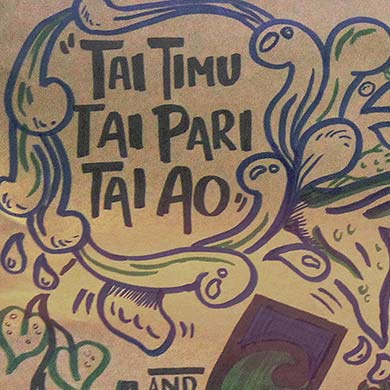DOC Treaty Partner Summit - Tai timu, tai pari, tai ao
Introduction
Whānau, hapū and iwi representatives from around the country attended the Department of Conservation’s Treaty Partner Summit. It was held at Te Papa Tongarewa in Wellington on 26 and 27 July 2018.“Mā te waha ā Tane, ka tika haere ngā mahi” - Let the voices of nature, guide our hands.
This two-day hui started with a simple ambition: to listen and learn from each other. We gained insights by listening to stories and examples from the past 30 years, some of which showed good practice and others that indicated areas we need to improve in.

Detail of visual storyboard day one
There were three keynote sessions. The themes were:
- Law vs Lore,
- Mātauranga Māori and
- Crown iwi relationships.
Each theme was supported by storytellers and panellists from the areas of expertise and a short Q & A session followed.
Available content from the hui is provided below.
Day one
Dr Charles Royal's summary of the day - audio (MP3, 9,196K)
Visual storyboards of day one:
International keynote speaker:
Kim Baird: The Tsawwassen First Nation Treaty - A Treaty Partner experience from Canada (PDF, 1,841)
Law vs Lore - finding the way forward
Prior to European contact, customary law or tikanga Māori was an effective social control and legal system for Māori. Colonisation had a detrimental effect, with new legal frameworks breaking down successful Māori systems and practices.
The question posed to hui attendees was – is there a way to look at mutual benefits between mātauranga Māori, tikanga Māori and New Zealand state law?
The Māori world view recognises people with direct whakapapa with the environment. This is outlined through legislation like the Ngāi Tahu Claims Settlement Act 1998, the Te Urewera Act 2014, and the Te Awa Tupua Whanganui River Claim Settlement Act 2017.
Jacinta Ruru keynote – YouTube video
Mātauranga Māori – a new system?
The next big theme was Mātauranga Māori. Mātauranga can be defined as ‘the knowledge, comprehension, or understanding of everything visible and invisible existing’.
Having Mātauranga Māori in our mahi is not just about creating a space for Māori ways of being and knowing, but it’s also about valuing the richness it brings to any kaupapa. It is understanding that there is no ‘one’ way to ‘know’ something and that the strength comes from multiple world views.
We need to acknowledge that Mātauranga Māori can deepen and enhance our work.
Mātauranga Māori is about a Māori way of being and engaging in the world – in its simplest form, it uses kawa (cultural practices) and tikanga (cultural principles) to critique, examine, analyse and understand the world. It’s also about putting systems in place like kaitiakitanga - applying systems creates space and opportunity to understand the environment’s influence on tangata whenua.
Dr Charles Royal keynote – YouTube video
Mātauranga Māori in practice: Peter Prime and Aaron Taikato (PDF, 1,885K)
Crown and Māori – so what happens next?
The history of the Treaty of Waitangi has been an essential part of Crown and Māori relations since it was signed it 1840. However, claims and breaches have been made to the Crown and New Zealand Governments for more than 160 years, and escalated more recently to the United Nations.
We asked: Has the Crown got it right? Have Māori got it right?
Haami Piripi gave the keynote address followed by storytellers Tahi Rangiawha, Francois Tumahai, Mark Davies, Te Kei Merito, Leonie Simpson and Jade King-Hazel. After that we had a short Q & A session.
- Haami Piripi keynote – YouTube video
- Waikato/Tainui cultural material plan: Tahi Rangiawha and Ngaa Rauira Puumanawawhiti (PDF, 1,668K)
- Ngāti Kahungunu ki Wairarapa: Robin Potangaroa and Reg Kemper (PDF, 2,399K)
- Te Tapatoru a Toi: Te Kei Merito, Leonie Simpson and Jade King-Hazel (PDF, 7,882K)
Day two
We began with a presentation offering an indigenous perspective from Glenise Coulthard and Stuart Paul from South Australia, who spoke about the co-management of national parks in South Australia.
This was followed by a speech from Lou Sanson, Director-General, Department of Conservation who took us back to DOC’s beginning in 1987. He showed an extract from a documentary made at the time and spoke about our Treaty Partner as our navigators.
- Dr Charles Royal's summary of the day - audio (MP3, 8,426K)
- Visual storyboard of day two - western science and Mātauranga Māori (PDF, 872K)
- Strong people, strong country:
- Taunaki Kawa mo te Taiao: Callum Lilley, Bonita Bigham, Hori Parata, Te Kaurinui Parata, Blake Te Kata and Jaycee Tipene-Thomas (PDF, 3,006K)
- Taranaki Mounga: Darryn Ratana (PDF, 3,593K)
- Science and Mātauranga Māori presentations:
- A rangatahi perspective from Hoku aka Mangaranga: Te Wehi Wright, Manawa Vercoe, Ngaa Rauira Puumanawawhiti, Rangipare Belshaw-Ngaropo (PDF, 571K)
Wrap up
Over the course of the two days, we heard a variety of stories told from a number of perspectives. These have allowed us to reflect on the journey we have taken over the past 30 years and inspired our thinking on the future.
The comments and mātauranga shared, including those from the whakawhiti kōrero session, will help inform the way forward for DOC in partnership with whānau, hapū and iwi.
Dr Charles Royal said: “I used the metaphor of the waka and that as we ascend the mast of creativity and innovation, of looking for new possibilities, of striking out to new horizons, of risking and trying different things, of failing occasionally, and going into new/discovering new possibilities of new taonga.
"As we go, ascend the mast of our innovation and creativity, we need to make sure that the keel is reaching deeper and deeper and deeper into the waters of our pre-existing knowledge, of our history, of our culture, of our identity”.
Ngā mihi
Hāpaitia te ara, poipoia te kākano – foster the pathway, nurture the seed.
